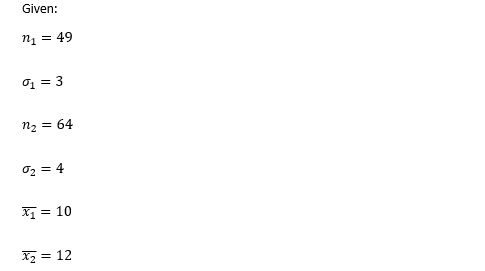A random sample of n1 = 49 measurements from a population with population standard deviation ?1 = 3 had a sample mean of x1 = 10. An independent random sample of n2 = 64 measurements from a second population with population standard deviation ?2 = 4 had a sample mean of x2 = 12. Test the claim that the population means are different. Use level of significance 0.01. (a) Check Requirements: What distribution does the sample test statistic follow? Explain. The Student's t. We assume that both population distributions are approximately normal with known standard deviations.The standard normal. We assume that both population distributions are approximately normal with known standard deviations. The Student's t. We assume that both population distributions are approximately normal with unknown standard deviations.The standard normal. We assume that both population distributions are approximately normal with unknown standard deviations. (b) State the hypotheses. H0: ?1 = ?2; H1: ?1 < ?2H0: ?1 ≠ ?2; H1: ?1 = ?2 H0: ?1 = ?2; H1: ?1 > ?2H0: ?1 = ?2; H1: ?1 ≠ ?2 (c) Compute x1 − x2. x1 − x2 = Compute the corresponding sample distribution value. (Test the difference ?1 − ?2. Round your answer to two decimal places.) Find the P-value of the sample test statistic. (Round your answer to four decimal places.)
A random sample of n1 = 49 measurements from a population with population standard deviation ?1 = 3 had a sample mean of x1 = 10. An independent random sample of n2 = 64 measurements from a second population with population standard deviation ?2 = 4 had a sample mean of x2 = 12. Test the claim that the population means are different. Use level of significance 0.01. (a) Check Requirements: What distribution does the sample test statistic follow? Explain. The Student's t. We assume that both population distributions are approximately normal with known standard deviations.The standard normal. We assume that both population distributions are approximately normal with known standard deviations. The Student's t. We assume that both population distributions are approximately normal with unknown standard deviations.The standard normal. We assume that both population distributions are approximately normal with unknown standard deviations. (b) State the hypotheses. H0: ?1 = ?2; H1: ?1 < ?2H0: ?1 ≠ ?2; H1: ?1 = ?2 H0: ?1 = ?2; H1: ?1 > ?2H0: ?1 = ?2; H1: ?1 ≠ ?2 (c) Compute x1 − x2. x1 − x2 = Compute the corresponding sample distribution value. (Test the difference ?1 − ?2. Round your answer to two decimal places.) Find the P-value of the sample test statistic. (Round your answer to four decimal places.)
MATLAB: An Introduction with Applications
6th Edition
ISBN:9781119256830
Author:Amos Gilat
Publisher:Amos Gilat
Chapter1: Starting With Matlab
Section: Chapter Questions
Problem 1P
Related questions
Topic Video
Question
A random sample of
n1 = 49
measurements from a population with population standard deviation
?1 = 3
had a sample mean of
x1 = 10.
An independent random sample of
n2 = 64
measurements from a second population with population standard deviation
?2 = 4
had a sample mean of
x2 = 12.
Test the claim that the population means are different. Use level of significance 0.01.
(a) Check Requirements: What distribution does the sample test statistic follow? Explain.
(b) State the hypotheses.
(c) Compute
Compute the corresponding sample distribution value. (Test the difference ?1 − ?2. Round your answer to two decimal places.)
Find the P-value of the sample test statistic. (Round your answer to four decimal places.)
The Student's t. We assume that both population distributions are approximately normal with known standard deviations.The standard normal. We assume that both population distributions are approximately normal with known standard deviations. The Student's t. We assume that both population distributions are approximately normal with unknown standard deviations.The standard normal. We assume that both population distributions are approximately normal with unknown standard deviations.
(b) State the hypotheses.
H0: ?1 = ?2; H1: ?1 < ?2H0: ?1 ≠ ?2; H1: ?1 = ?2 H0: ?1 = ?2; H1: ?1 > ?2H0: ?1 = ?2; H1: ?1 ≠ ?2
(c) Compute
x1 − x2.
x1 − x2 =
Compute the corresponding sample distribution value. (Test the difference ?1 − ?2. Round your answer to two decimal places.)
Find the P-value of the sample test statistic. (Round your answer to four decimal places.)
Expert Solution
Step 1 Introduction

Step by step
Solved in 2 steps with 3 images

Knowledge Booster
Learn more about
Need a deep-dive on the concept behind this application? Look no further. Learn more about this topic, statistics and related others by exploring similar questions and additional content below.Recommended textbooks for you

MATLAB: An Introduction with Applications
Statistics
ISBN:
9781119256830
Author:
Amos Gilat
Publisher:
John Wiley & Sons Inc

Probability and Statistics for Engineering and th…
Statistics
ISBN:
9781305251809
Author:
Jay L. Devore
Publisher:
Cengage Learning

Statistics for The Behavioral Sciences (MindTap C…
Statistics
ISBN:
9781305504912
Author:
Frederick J Gravetter, Larry B. Wallnau
Publisher:
Cengage Learning

MATLAB: An Introduction with Applications
Statistics
ISBN:
9781119256830
Author:
Amos Gilat
Publisher:
John Wiley & Sons Inc

Probability and Statistics for Engineering and th…
Statistics
ISBN:
9781305251809
Author:
Jay L. Devore
Publisher:
Cengage Learning

Statistics for The Behavioral Sciences (MindTap C…
Statistics
ISBN:
9781305504912
Author:
Frederick J Gravetter, Larry B. Wallnau
Publisher:
Cengage Learning

Elementary Statistics: Picturing the World (7th E…
Statistics
ISBN:
9780134683416
Author:
Ron Larson, Betsy Farber
Publisher:
PEARSON

The Basic Practice of Statistics
Statistics
ISBN:
9781319042578
Author:
David S. Moore, William I. Notz, Michael A. Fligner
Publisher:
W. H. Freeman

Introduction to the Practice of Statistics
Statistics
ISBN:
9781319013387
Author:
David S. Moore, George P. McCabe, Bruce A. Craig
Publisher:
W. H. Freeman